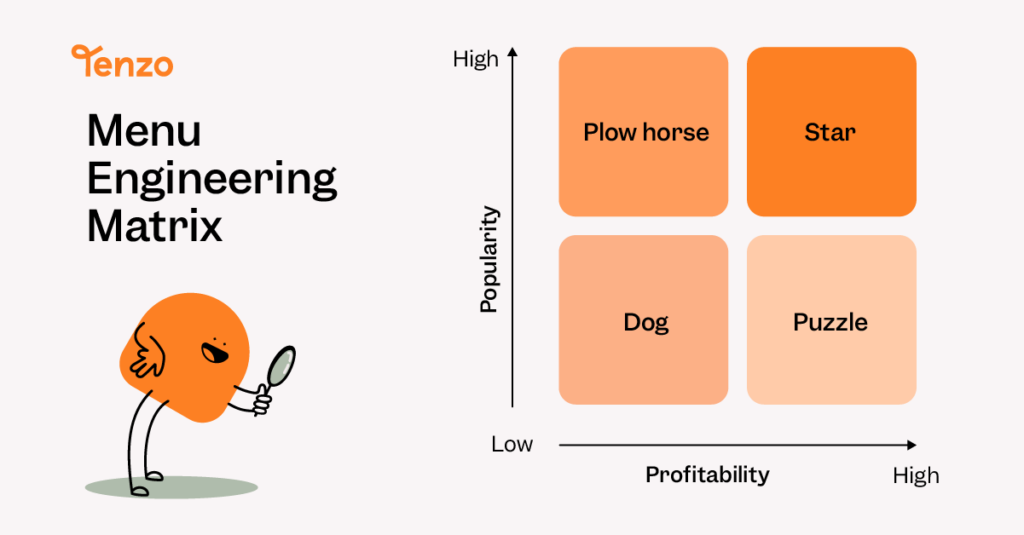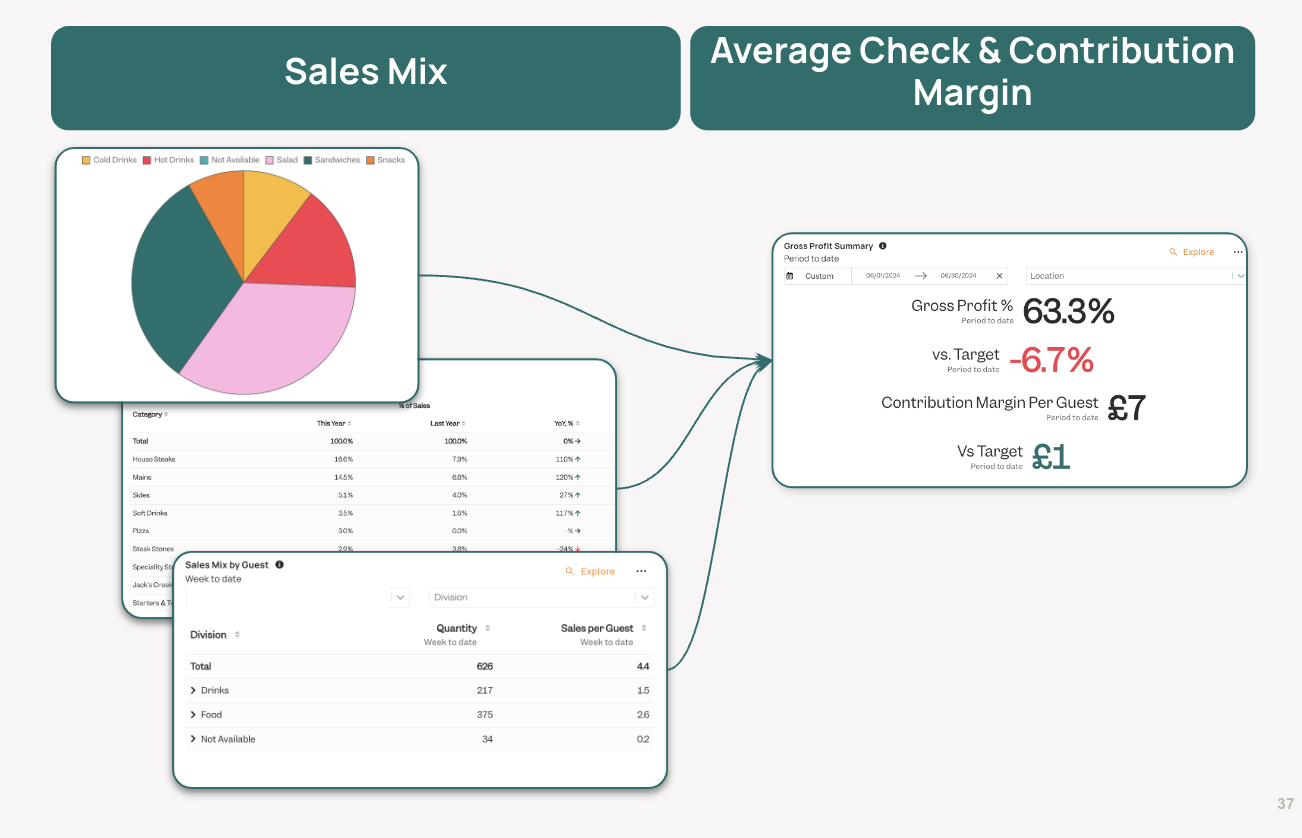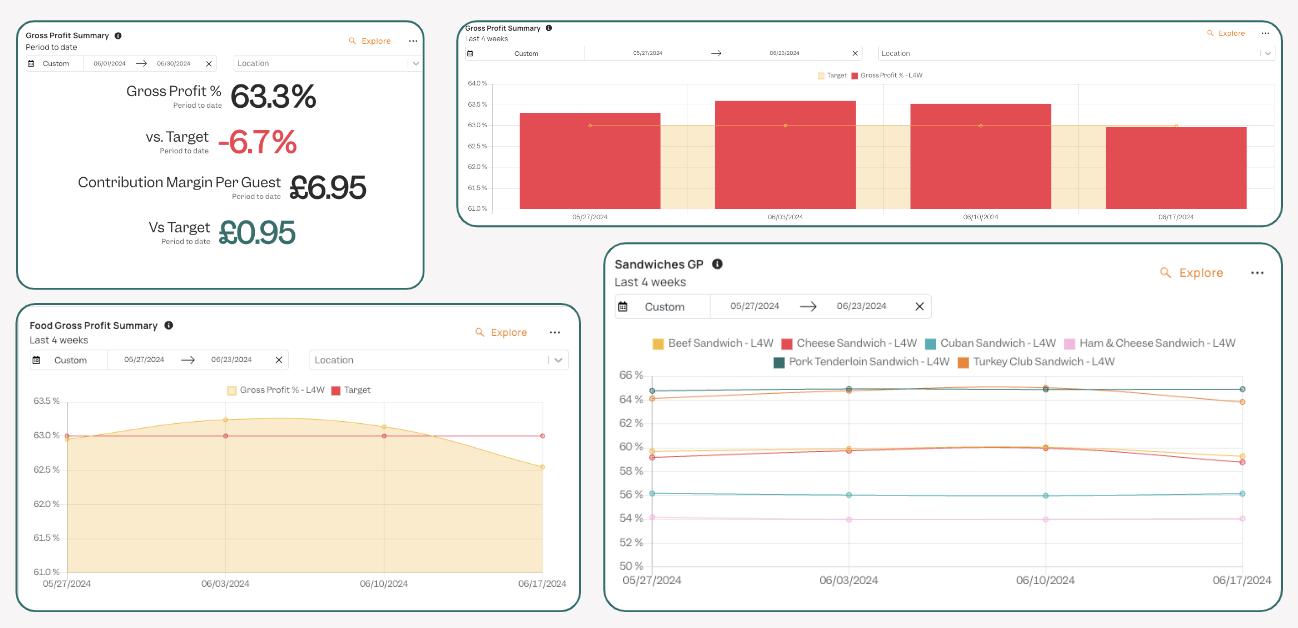Menu engineering is a constant hot topic in the restaurant industry. Getting your menu right can reap huge rewards, but getting it wrong can be a complete disaster.
However, you may be missing a key component to successfully engineer your menu: Contribution Margins.
In this blog, we’ll be breaking down how menu engineering with Contribution Margins alongside Gross Profit Margins can be the answer to powering up your business’ performance.
Menu engineering key terms and definitions
First, a few key terms and definitions that are helpful to understand:
Gross Profit Margin
Gross Profit Margin’s formula is the following:
(Price of dish) – (cost of goods sold)/price of dish = Gross Profit Percentage
Example: Cheeseburger sells for £10 and costs £3, so the Gross Profit Percentage is 70%
Contribution Margin
When it comes to your menu items, the Contribution Margin is as follows:
(Price of dish) – (cost of goods sold) = Contribution Margin
This is different to Gross Profit Margin because it is the actual dollar or pound amount that you make back on each dish before other variable costs.
Example: Cheeseburger sells for £10, and costs £3, so the Contribution Margin is £7
Sales mix
Your revenue breakdown by menu category or menu item.
Example: Your total revenue is £500, you sold £150 worth of cheeseburgers so your cheeseburgers make up 30% of your sales mix.
The basics of menu engineering
Menu engineering tends to start with a matrix like the one below.

It involves plotting your dishes on the graph depending on how popular and profitable they are. Your most popular and profitable dishes are stars and your least profitable and popular ones are dogs.
To assemble this matrix, you need to understand how much each dish costs to make by costing out the ingredients involved in each dish as well as how often it is ordered proportional to your full sales mix. The problem is ingredient pricing varies and what could be a good deal one month could be very expensive the next. Popularity is also seasonal so what is popular during the summer is not likely a hit in the middle of winter.
That’s why menu reviews should be done on at least a quarterly basis or any time there’s a big increase in the cost of a key ingredient.
Without automation in place, this is a complex and time-consuming exercise, but if you use a stock management system set up correctly and have robust sales reporting in place, it should be relatively simple.
The problems with basic menu engineering
We’ve noticed a few problems with menu engineering is sometimes approached.
Problem 1
The most common mistake is using Gross Profit % as a measure of profitability instead of Contribution Margin.
If you are only considering the ratio of popularity to food cost in percentage terms (e.g. this dish costs 30% of the price to make and is ordered 20% of the time), the actual numbers hitting your bottom line get left behind.
Imagine this scenario: You have pizza and steak on your menu. The price of a pizza is £10, the steak is £24. The cost of goods for the pizza is £3, whereas the steak’s is £12. This means that the pizza’s Gross Profit Percentage is 70% and the steak’s is 50%. If you just work with that percentage, you’d say you need to push pizza and possibly remove steak from the menu (in this scenario customers won’t pay any more for steak).
However, if you look at the Contribution Margins of each item, they tell another story. Pizza’s Contribution Margins are £7, but the steak’s are £12. So if you’re looking to increase the actual profit in the business, then pushing the steak will net you better results.
Problem 2
The second problem is that teams compare all their menu items against each other, instead of creating a new matrix for each menu category. If you don’t segment your menu and compare starters, mains, sides, etc on one matrix, it will be too busy and lack customer ordering context. Logically, we shouldn’t expect the nachos to have the same Contribution Margin as the Ribeye.
Problem 3
The third problem is groups understand their theoretical gross profit margin very well, but struggle to see how their sales mix affects their profitability especially by day of the week and by day part. Add in more price-sensitive customers “trading down” (ordering less expensive items as a way of saving money on indulgences like going out to eat) and restaurants end up being in the dark about what their actual profit margin is.
If you can dive deeper into the numbers you can make more informed decisions around:
- Bundling items to sacrifice GP but drive CM
- Substitute ingredients to lower COGS
- Raise price
- Reduce portion size
Tenzo’s approach to menu engineering
Step 1: Set Contribution Margin target by guest
The first thing to understand is how much you want to profit off of each guest. You can choose to do this based on covers (if you record this in your POS) or estimate by number of mains sold (1 main = 1 guest).
Note: if you are choosing to use number of mains, your CM target should include their add-ons as well. Number of mains is just a way to approximate guest numbers
Step 2: Estimate average ticket value (ATV) or average sales mix per guest by category
Look at each of your menu categories (i.e. starters, mains, drinks, etc) and calculate either how much the average guest spends per category or how often the average guest orders each category.
Example: £4 on starters, £15 on mains, £2.50 on drinks per guest or 0.7 starters, 1 main, 0.5 drinks per guest

Step 3: Set average Contribution Margin goal by menu category
Looking at your goal contribution margin by guest and your average ticket value or sales mix assess how much contribution margin should be generated by each menu category.
Example: starters average CM should be £3, mains, £10, etc
Step 4: Set or review prices by menu category and review ATV
Once you’ve decided on what the CM per category should be, review your current prices and costs to see if changes need to be made. It’s helpful to look at this as an average across the category as there will always be outliers.
If your average for the category falls below your goal, review each item to see where changes could be made to get you to the average goal.

Now look at your sales mix and see how price increases impact your ATV. Is your ATV realistic? Will your customers be willing to pay that amount?

Step 5: Review the impact of sales mix on the Contribution Margin by menu category
Make sure that your sales mix is healthy enough to make the average contribution achievable even with outliers. In other words, if the majority of your orders come from dishes with a low contribution margin, you’ll need to reassess the pricing strategy to make sure you’re capable of hitting that target.

Step 7: Score your product items within each menu category
Score each of your menu items in the original matrix by looking at each item’s contribution margin and their sales mix. You can quickly see which items need to be removed or repriced.

Step 8: Regularly review targets and how you’re performing against them
Keep track of how you’re performing against your goals constantly. Looking at these numbers weekly or even daily can alert you to any changes you need to make before they become larger issues.

Use Tenzo for menu engineering
Trying to look at these numbers by manually compiling costs and prices is extremely complex and tedious. That’s why the majority of restaurants don’t do it.
Additionally, doing this analysis within your inventory tool can be difficult as inventory tools don’t have a granular enough POS integration or powerful reporting to be able to give you level of detail you need on the impact of sales mix by day/ day part.
But if you have a PerformanceOps platform like Tenzo in place alongside your other pieces of operational tech, you can always be aware of any outside forces that may be impacting your profitability.
Plus, sometimes setups are not configured properly which can lead to items having no cost associated with them in your inventory tool, throwing off all of your menu engineering process. Tenzo can help you find any items with 0 cost associated and make sure that your set-up is working the way it should.
Get in touch today to see how Tenzo can help your business!
Note: menu engineering is currently available to our Alpha User group who get to try new features first – it is also integration-dependent.




